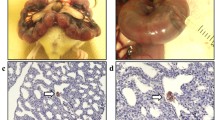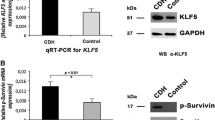Abstract
Purpose
The aim of this study was to evaluate the efficacy of mesenchymal stem cells (MSCs) in a nitrofen-induced congenital diaphragmatic hernia (CDH) rat model.
Methods
Pregnant rats were exposed to nitrofen on embryonic day 9.5 (E9.5). MSCs were isolated from the enhanced green fluorescent protein (eGFP) transgenic rat lungs. The MSCs were transplanted into the nitrofen-induced E12.5 rats via the uterine vein, and the E21 lung explants were harvested. The study animals were divided into three: the control group, the nitrofen-induced left CDH (CDH group), and the MSC-treated nitrofen-induced left CDH (MSC-treated CDH group). The specimens were morphologically analyzed using HE and immunohistochemical staining with proliferating cell nuclear antigen (PCNA), surfactant protein-C (SP-C), and α-smooth muscle actin.
Results
The alveolar and medial walls of the pulmonary arteries were significantly thinner in the MSC-treated CDH group than in the CDH group. The alveolar air space areas were larger, while PCNA and the SP-C positive cells were significantly higher in the MSC-treated CDH group, than in the CDH group. MSC engraftment was identified on immunohistochemical staining of the GFP in the MSC-treated CDH group.
Conclusions
MSC transplantation potentially promotes alveolar and pulmonary artery development, thereby reducing the severity of pulmonary hypoplasia.




Similar content being viewed by others
References
Masumoto K, Teshiba R, Esumi G, Nagata K, Takahata Y, Hikino S, Hara T, Hojo S, Tsukimori K, Wake N, Kinukawa N, Taguchi T (2009) Improvement in the outcome of patients with antenatally diagnosed congenital diaphragmatic hernia using gentle ventilation and circulatory stabilization. Pediatr Surg Int 25:487–492
Nagata K, Usui N, Kanamori Y, Takahashi S, Hayakawa M, Okuyama H, Inamura N, Fujino Y, Taguchi T (2013) The current profile and outcome of congenital diaphragmatic hernia: a nationwide survey in Japan. J Pediatr Surg 48:738–744
Takayasu H, Nakazawa N, Montedonico S, Sugimoto K, Sato H, Puri P (2007) Impaired alveolar epithelial cell differentiation in the hypoplastic lung in nitrofen-induced congenital diaphragmatic hernia. Pediatr Surg Int 23:405–410
Esumi G, Masumoto K, Teshiba R, Nagata K, Kinoshita Y, Yamaza H, Nonaka K, Taguchi T (2011) Effect of insulin-like growth factors on lung development in a nitrofen-induced CDH rat model. Pediatr Surg Int 27:187–192
Gonzalez-Reyes S, Alvarez L, Diez-Pardo JA, Tovar JA (2003) Prenatal vitamin E improves lung and heart hypoplasia in experimental diaphragmatic hernia. Pediatr Surg Int 19:331–334
Schmidt AF, Gonçalves FLL, Regis AC, Gallindo RM, Lourenço S (2012) Prenatal retinoic acid improves lung vascularization and VEGF expression in CDH rat. Am J Obstet Gynecol 207:76.e25–76.e32
Deprest J, De Coppi P (2012) Antenatal management of isolated congenital diaphragmatic hernia today and tomorrow: ongoing collaborative research and development. J Pediatr Surg 47:282–290
Jani J, Nicolaides KH, Keller RL, Benachi A, Peralta CF, Favre R, Moreno O, Tibboel D, Lipitz S, Eggink A, Vaast P, Allegaert K, Harrison M, Deprest J, Antenatal-CDH-Registry Group (2007) Observed to expected lung area to head circumference ratio in the prediction of survival in fetuses with isolated diaphragmatic hernia. Ultrasound Obstet Gynecol 30:67–71
Jani J, Valencia C, Cannie M, Vuckovic A, Sellars M, Nicolaides KH (2011) Tracheal diameter at birth in severe congenital diaphragmatic hernia treated by feto endoscopic tracheal occlusion. Prenat Diagn 31:699–704
de Coppi Paolo, Deprest Jan (2012) Regenerative medicine for congenital diaphragmatic hernia: regeneration for repair. Eur J Pediatr Surg 22:393–398
Hematti P (2008) Role of mesenchymal stromal cells in solid organ transplantation. Transpl Rev 22:262–273
Hoffman AM, Paxson JA, Mazan MR, Davis AM, Tyagi S, Murthy S, Ingenito EP (2011) Lung-derived mesenchymal stromal cell post-transplantation survival, persistence, paracrine expression, and repair of elastase-injured lung. Stem Cells Dev 20:1779–1792
Zhu X, Shi W, Tai W, Liu F (2012) The comparison of biological characteristics and multilineage differentiation of bone marrow and adipose derived mesenchymal stem cells. Cell Tissue Res 11:277–287
Aslam M, Baveja R, Liang OD, Fernandez-Gonzalez A, Lee C, Mitsialis SA, Kourembanas S (2009) Bone marrow stromal cells attenuate lung injury in a murine model of neonatal chronic lung disease. Am J Respir Crit Med 180:1122–1130
van Haaften T, Thébaud B (2006) Adult bone marrow derived stem cell for the lung: implications for pediatric lung disease. Pediatr Res 59:94–99
Pua JZ, Stonestreet BS, Cullen A, Shahsafaei A, Sadowska GB, Sunday ME (2005) Histochemical analyses of altered fetal lung development following single vs multiple courses of antenatal steroids. J Histochem Cytochem 53:1469–1479
Wu S, Platteau A, Chen S, McNamara G, Whitsett J, Bancalari E (2010) Conditional overexpression of connective tissue growth factor disrupts postnatal lung development. Am J Respir Cell Mol Biol 42:552–563
Kitaguchi Y, Taraseviciene-Stewart L, Hanaoka M, Natarajan R, Kraskauskas D, Voelkel N (2012) Acrolein induces endoplasmic reticulum stress and causes airspace enlargement. PLoS One 7(5):e38038. doi:10.1371/journal.pone.0038038
Hansmann G, Fernandez-Gonzalez A, Aslam M, Vitali SH, Martin T, Mitsialis SA, Kourembanas S (2012) Mesenchymal stem cell-mediated reversal of bronchopulmonary dysplasia and associated pulmonary hypertension. Pulm Circ 2:170–181
Okoye BO, Losty PD, Lloyd DA, Gosney JR (1998) Effect of prenatal glucocorticoids on pulmonary vascular muscularisation in nitrofen-induced congenital diaphragmatic hernia. J Pediatr Surg 33:76–80
Pozzobon M, Ghionzoli M, De Coppi P (2010) ES, iPS, MSC, and AFS cells. Stem cells exploitation for pediatric surgery: current research and perspective. Pediatr Surg Int 26:3–10
Crisostomo PRM, Markel TA, Wang Y, Meldrum DR (2008) Surgically relevant aspects of stem cell paracrine effects. Surgery 143:577–581
Ardhanareeswaran K, Miratsou M (2013) Lung stem and progenitor cells. Respiration 85:89–95
Keating A (2012) Mesenchymal stromal cells: new directions. Stem Cell 10:709–716
Ingenito EP, Tsai L, Murthy S, Tyagi S, Mazan M, Hoffman A (2012) Autologous lung-derived mesenchymal stem cell transplantation in experimental emphysema. Cell Transpl 21:175–189
Chen CP, Lee MY, Huang JP, Aplin JD, Wu YH, Hu CS, Chen PC, Li H, Hwang SM, Liu SH, Yang YH (2008) Trafficking of multipotent mesenchymal stromal cells from maternal circulation through the placenta involves vascular endothelial growth factor receptor-1 and integrins. Stem Cells 26:550–561
Badri L, Walker NM, Ohtsuka T, Wang Z, Delmar M, Flint A, Golden MP, Toews GB, Pinsky DJ, Krebsbach PH, Lama VN (2011) Epithelial interactions and local engraftment of lung-resident mesenchymal stem cells. Am J Respir Cell Mol Biol 45:809–816
Lee JW, Fang X, Krasnodembskaya A, Howard JP, Matthay MA (2011) Concise review: mesenchymal stem cells for acute lung injury: role of paracrine soluble factors. Stem Cells 29:913–919
Zhu F, Xia ZF (2013) Paracrine activity of stem cells in therapy for acute lung injury and adult respiratory distress syndrome. J Trauma Acute Care Surg 74:1351–1356
Conese M, Carbone A, Castellani S, Gioia SD (2013) Paracrine effects and heterogeneity of marrow-derived stem/progenitor cells: relevance for the treatment of respiratory diseases. Cell Tissues Organs 197:445–473
Di Bernardo J, Maiden MM, Hershenson MB, Kunisaki SM (2014) Amniotic fluid derived mesenchymal stem cells augment fetal lung growth in a nitrofen explant model. J Pediatr Surg. doi:10.1016/j.jpedsurg.2014.01.013
Pederiva F, Ghionzoli M, Pierro A, De Coppi P, Tovar JA (2013) Amniotic fluids stem cells rescue both in vitro and in vivo growth, innervation, and motility in nitrofen-exposed hypoplastic rat lungs through paracrine effects. Cell Transpl 22:1683–1694
Acknowledgments
The authors wish to thank Mr. Brian Quinn for supporting the manuscript. This work was supported in part by a Grant-in-Aid for Scientific Research from the Japanese Society for the Promotion of Science.
Conflict of interest
The authors do not have any conflicts of interest related to this paper.
Author information
Authors and Affiliations
Corresponding author
Rights and permissions
About this article
Cite this article
Yuniartha, R., Alatas, F.S., Nagata, K. et al. Therapeutic potential of mesenchymal stem cell transplantation in a nitrofen-induced congenital diaphragmatic hernia rat model. Pediatr Surg Int 30, 907–914 (2014). https://doi.org/10.1007/s00383-014-3576-9
Accepted:
Published:
Issue Date:
DOI: https://doi.org/10.1007/s00383-014-3576-9




